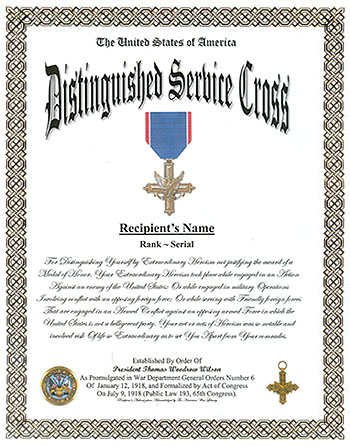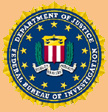 |
Distinguished Service Cross
Display Recognition![]()
Site Index
 |
Distinguished Service Cross
Display Recognition![]()
Site Index
Example Display Recognition:
Actual Size: 8 1/2 x 11

![]()
![]()
You have four display types to choose from:
Black & White (No Color)
Heavy Bond Enclosure
 |
Heavy Bond Enclosure Colors: Regal, Black, Navy Trimmed in Appearance Gold Ready for Mantle or Shelf Display |
|---|
 |
|---|
![]()
Issue Requirements
You must submit the following:
This Display Recognition is available ONLY to authorized recipients who possess orders, or authorization form, or release documentation that confirms award eligibility. (See "Issue Requirements"). To obtain either a Display Medal or a Display Recognition for your authorized award you will be required to provide military-issued documentation authorizing your award. There are no exceptions.
You must NOT submit a military issued document or photocopy that:
the original's official issue
additions that you entered Be advised that on request any knowingly fraudulent document sent by you will be released to the Federal Bureau of Investigation (FBI) that may result in prosecution and/or fine/imprisonment.
Be advised that on request any knowingly fraudulent document sent by you will be released to the Federal Bureau of Investigation (FBI) that may result in prosecution and/or fine/imprisonment.
Personnel Branch
Processing and Delivery
| Style | Admin | Shipping | Total | Full Color .PDF (Printable) | $7.50 | Emailed | $7.50 | Published Document only (Full Color) | $14.00 | $12.11 USPS | $26.11 | Published Document in Heavy Bond Enclosure (Full Color) | $19.00 | $12.11 USPS | $31.11 |
|---|
You may apply for your Display Recognition using a...
(* Upon reception of required documentation)
Complete and MAIL this APPLICATION FORM.
Don't forget to include an unaltered COPY of your DD-214, WD AGO 53-55 or other pre-arranged document(s).
![]()
Click here for answers to common questions
Email: DSC Display Recognition InquiryTelephone: 1-562-422-4100 (Pacific Time Zone)
![]()
Copyright © ![]() The American War Library
The American War Library
Military and Veteran Websites
The G.I. Photograph Museum of Honor
Locator Registry Applications
Accessing The Worldwide Military Personnel Database
Establishing Authority

Click for larger image
The Distinguished Service Cross was established by order of President Woodrow Wilson, as promulgated in War Department General Orders Number 6 of January 12, 1918, and formalized by Act of Congress on July 9, 1918 (Public Law 193, 65th Congress).
Effective Dates
The Distinguished Service Cross has been in effect since April 6, 1917; however, under certain circumstances the Distinguished Service Cross may be awarded for services rendered prior to April 6, 1917 (see information provided under the Recognition of Merit).
Criteria
The Distinguished Service Cross may awarded to a person who, while serving in any capacity with the Army, distinguishes himself by extraordinary heroism not justifying the award of a Medal of Honor. This extraordinary heroism must take place while the individual is engaged in an action against an enemy of the United States; or while he is engaged in military operations involving conflict with an opposing foreign force; or while he is serving with friendly foreign forces that are engaged in an armed conflict against an opposing armed force in which the United States is not a belligerent party. The act or acts of heroism must be so notable and involve risk of life so extraordinary as to set the individual apart from his comrades.
Order of Precedence
The Distinguished Service Cross is worn after the Medal of Honor and before all other decorations.
Devices
Additional awards are denoted by oak leaf clusters.
Designers
The Distinguished Service Cross was designed by First Lieutenant Andre Smith and modified by Captain Aymar Embury, both of the Camouflage Section, 40th Engineers, at Camp American University. Embury's final design was sculpted by John R. Sinnock of the Philadelphia Mint.
First Recipients
The first awards of the Distinguished Service Cross were made on March 18, 1918, to three soldiers from the 1st Division: Second Lieutenant John Newport Greene of the 6th Field Artillery and to Sergeant William M. Norton and Private Patrick Walsh, both of Company I, 18th Infantry.
Description and Symbolism of the First Style Distinguished Service Cross
Obverse
The first style Distinguished Service Cross was struck in bronze and is one and seven-eighths inches in height and one and five-eighths inches wide. The suspender was originally part of the overall design of the medal; however, it proved unworkable and was replaced by a ball through which the suspension ring was passed. The central feature of the medal is an eagle centered on the cross over a four-pointed diamond outline with one point centered in each arm of the cross and with a five-pointed star at each point of the diamond. The eagle's wings are displayed and extend into the upper re-entrant angles of the cross. The arms of the cross are heavily decorated with oak leaves, and below the eagle in the lower re-entrant angles of the cross is a scroll bearing the inscription, E PLURIBUS UNUM.
The eagle represents the bald eagle and symbolizes the United States. The five-pointed stars are taken from the United States flag and refer collectively to the United States, just as the inscription on the scroll refers to the fact that the United States is one nation composed of many states. The oak leaves stand for strength and courage. The inscription on the scroll is taken from the Great Seal of the United States and refers to the United States as one nation composed of many peoples.
Reverse
In the center of the cross is a rectangular plaque containing the inscription, FOR VALOR. The plaque rests on a circular wreath of laurel leaves in the center of which appears a decorative staff. The laurel wreath represents victory and achievement.
Ribbon
The ribbon was designed by Captain Andre Smith and has a central field of blue (one inch wide) edged in white and red, with the red forming the outermost colors of the ribbon. The colors of the ribbon are those of the flag and stand for purity (white), sacrifice (red), and high purpose (blue).
Description and Symbolism of the Second (Current) Style Distinguished Service Cross
Obverse
The second style Distinguished Service Cross is a modification of the first style; it has a sculptured inner cross mounted on a flat cross with decorative, fluted edges. At the end of each arm is a small ornamental scroll topped by a ball. An eagle with displayed wings is centered on the cross and behind the eagle is a circular wreath of laurel (which replaces the diamond in the first style cross). The laurel wreath is tied at its base by a scroll which extends into the lower re-entrant angles of the cross and contains, FOR VALOR.
Reverse
The reverse also features a sculptured inner cross on a flat cross, with the same decorations at the edges that appear on the obverse. The back and tips of the eagles wings are also shown. Centered upon the cross is a circular wreath of laurel with a bowknot at the bottom from which flows the back of the scroll, joining the arms of the cross. In the center of the wreath is a rectangular plaque with decorative edges, which is blank for engraving the recipient's name.
Ribbon
Same as for the first style Distinguished Service Cross.
1. Description: A cross of bronze, 2 inches in height and 1 13/16 inches in width with an eagle on the center and a scroll below the eagle bearing the inscription "FOR VALOR". On the reverse side, the center of the cross is circled by a wreath with a space for engraving the name of the recipient.
2. Ribbon: The ribbon is 1 3/8 inches wide and consists of the following stripes: 1/8 inch Old Glory Red 67156; 1/16 inch White 67101; 1 inch Imperial Blue 67175; 1 1/16 inch White; and 1/8 inch Old Glory Red.
3. CRITERIA: The Distinguished Service Cross is awarded to a person who, while serving in any capacity with the Army, distinguishes himself or herself by extraordinary heroism not justifying the award of a Medal of Honor; while engaged in an action against an enemy of the Unites States; while engaged in military operations involving conflict with an opposing/foreign force; or while serving with friendly foreign forces engaged in an armed conflict against an opposing Armed Force in which the United States is not a belligerent party. The act or acts of heroism must have been so notable and have involved risk of life so extraordinary as to set the individual apart from his or her comrades.
4. Components: The following are authorized components of the Distinguished Service Cross:
a. Decoration (regular size): MIL-D-3943/4. NSN 8455-00-269-5745 for decoration set. NSN 8455-00-246-3827 for individual replacement medal.
b. Decoration (miniature size): MIL-D-3943/4. NSN 8455-00-996-50007.
c. Ribbon: MIL-R-11589/50. NSN 8455-00-252-9919.
d. Lapel Button (metal replica of ribbon bar): MIL-L-11484/1. NSN 8455-00-253-0808.
5. BACKGROUND: a. The Distinguished Service Cross was established by President Woodrow Wilson on January 2, 1918. General Pershing, Commander-in-Chief of the Expeditionary Forces in France, had recommended that recognition other than the Medal of Honor, be authorized for the Armed Forces of the United States for service rendered, in like manner, to that awarded by the European Armies. The request for establishment of the medal was forwarded from the Secretary of War to the President in a letter dated December 28, 1917. The Act of Congress establishing this award (193-65th Congress) dated July 9, 1918 is contained in Title 10 United States Code (USC) 3742. The establishment of the Distinguished Service Cross was promulgated in War Department General Order No. 6, dated January 12, 1918.
b. The first design of the Distinguished Service Cross was cast and manufactured by the United States Mint at Philadelphia. The die was cast from the approved design prepared by Lieutenant Aymar E. Embry, Engineers Officer Reserve Corps. Upon examination of the first medals struck at the Mint, it was considered advisable to make certain minor changes to add to the beauty and the attractiveness of the medal. Due to the importance of the time element involved in furnishing the decorations to General Pershing, one hundred of the medals were struck from the original design and numbered 1 to 100. These medals were furnished with the provision that these crosses be replaced when the supply of the second design was accomplished which would also be numbered 1 to 100.
c. Title 10, USC 3991, provides for a 10% increase in retired pay for enlisted personnel who have retired with more than 20 years of service if they have been awarded the Distinguished Service Cross.
d. Order of precedence and wear of decorations is contained in Army Regulation (AR) 670-1. Policy for awards, approving authority, supply, and issue of decorations is contained in AR 600-8-22.